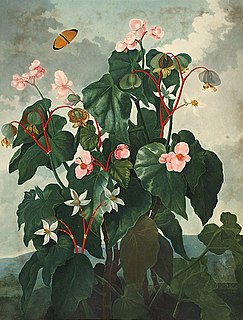
Begonia is a genus of perennial flowering plants in the family Begoniaceae. The genus contains more than 1,800 different plant species. The Begonias are native to moist subtropical and tropical climates. Some species are commonly grown indoors as ornamental houseplants in cooler climates. In cooler climates some species are cultivated outside in summertime for their bright colorful flowers, which have sepals but no petals.

The Royal Horticultural Society (RHS), founded in 1804 as the Horticultural Society of London, is the UK's leading gardening charity.

Acer campestre, known as the field maple, is a flowering plant species in the family Sapindaceae. It is native to much of continental Europe, Britain, southwest Asia from Turkey to the Caucasus, and north Africa in the Atlas Mountains. It has been widely planted, and is introduced outside its native range in Europe and areas of USA and Western Australia with suitable climate.

Caputia tomentosa, known as the woolly senecio and the matted caputia, is a perennial, succulent dwarf shrub of the Caputia genus that grows in the Cape Provinces of South Africa, usually between the altitudes of 900 and 1200 meters. It has been introduced to Myanmar. It has gained the Royal Horticultural Society's Award of Garden Merit as an ornamental.

Iris foetidissima, the stinking iris, gladdon, Gladwin iris, roast-beef plant, or stinking gladwin, is a species of flowering plant in the family Iridaceae, found in open woodland, hedgebanks and sea-cliffs.

Begonia grandis, the hardy begonia, is a species of flowering plant in the family Begoniaceae. This herbaceous perennial has alternate, simple leaves on arching stems. The flowers are pink or white, borne in dichotomously branching cymes from late summer through fall in USDA U.S. Hardiness Zone 7. As the common name "hardy begonia" implies, it is winter hardy in some temperate regions.

Agapanthus inapertus, the Drakensberg agapanthus, drooping agapanthus, or closed African lily, is a species of flowering plant in the family Amaryllidaceae, native to open grasslands, forest margins and mountainous, rocky areas of Mozambique, Eswatini (Swaziland), and South Africa.

Drosera slackii is a subtropical sundew native to the Cape Provinces of South Africa. It forms rosettes that range from to two to four inches in diameter, and produces pink flowers. It is named after the British plantsman and author Adrian Slack (1933-2018).
Cannomois is a group of plants in the Restionaceae described as a genus in 1828. The entire genus is endemic to Cape Province in South Africa.
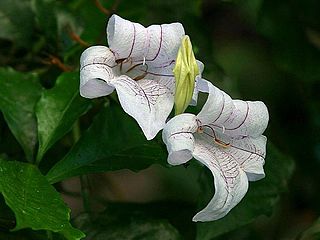
Mackaya is a genus of flowering plants in the family Acanthaceae, disjunctly distributed in Brazil, South Africa, and the eastern Himalayas, Southeast Asia and China. It is sister to Asystasia.
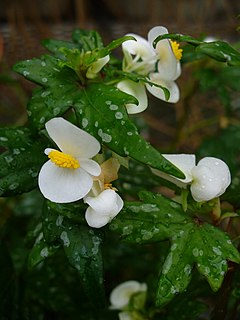
Begonia dregei, the maple leaf begonia or grape-leaf begonia, is a species of flowering plant in the genus Begonia native to South Africa. It has gained the Royal Horticultural Society's Award of Garden Merit.

Lachenalia corymbosa, the corymbous Cape cowslip, is a species of flowering plant in the genus Lachenalia native to the southwest Cape Provinces of South Africa. It has gained the Royal Horticultural Society's Award of Garden Merit.

Lachenalia longituba is a species of flowering plant in the genus Lachenalia, native to the Roggeveld plateau of South Africa. It has gained the Royal Horticultural Society's Award of Garden Merit.
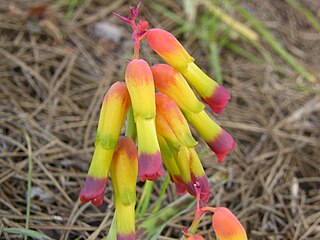
Lachenalia quadricolor, the four‑coloured opal flower, is a species of flowering plant in the genus Lachenalia, native to the southwest Cape Provinces of South Africa. It has gained the Royal Horticultural Society's Award of Garden Merit.

Lachenalia viridiflora, the green-flowered Cape cowslip, is a species of flowering plant in the genus Lachenalia, native to the southwest Cape Provinces of South Africa. It has gained the Royal Horticultural Society's Award of Garden Merit.

Mackaya bella, called the forest bell bush, is a species of flowering plant in the genus Mackaya, native to South Africa. It has gained the Royal Horticultural Society's Award of Garden Merit.
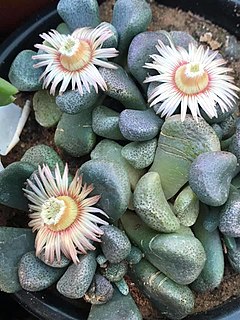
Aloinopsis schooneesii is a species of flowering plant in the genus Aloinopsis, in the ice plant family Aizoaceae, native to the eastern Cape Provinces of South Africa. It has gained the Royal Horticultural Society's Award of Garden Merit.
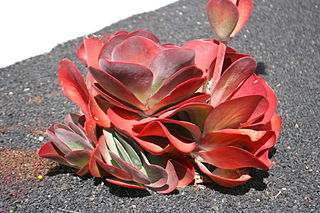
Kalanchoe luciae, the paddle plant, is a species of flowering plant in the genus Kalanchoe, native to northeast South Africa, Swaziland, Mozambique and Zimbabwe. It has gained the Royal Horticultural Society's Award of Garden Merit.

Trichodiadema barbatum is succulent plant of the genus Trichodiadema, native to the Western Cape Province, South Africa. It has gained the Royal Horticultural Society's Award of Garden Merit.

Carpanthea pomeridiana, the afternoon carpanthea, is a species of flowering plant in the genus Carpanthea, native to the western Cape Provinces of South Africa, and introduced to New South Wales, Australia. It has gained the Royal Horticultural Society's Award of Garden Merit as an ornamental.



















